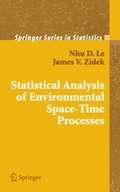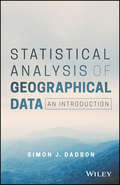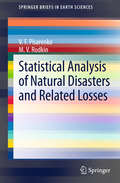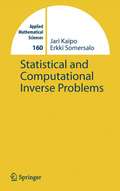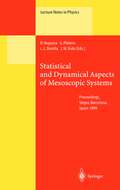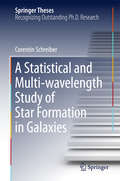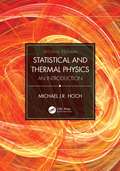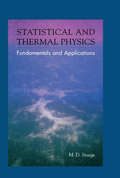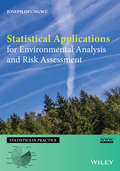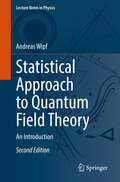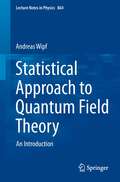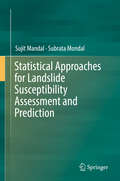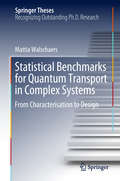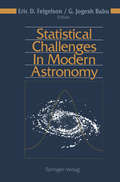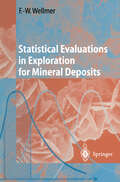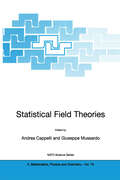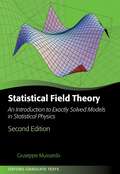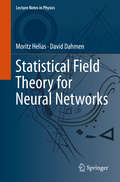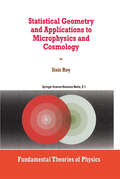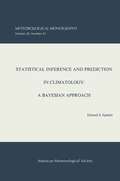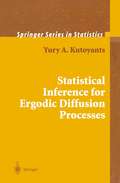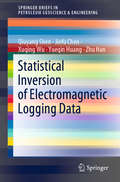- Table View
- List View
Statistical Analysis of Environmental Space-Time Processes (Springer Series in Statistics)
by Nhu D. Le James V. ZidekThis book provides a broad introduction to the subject of environmental space-time processes, addressing the role of uncertainty. It covers a spectrum of technical matters from measurement to environmental epidemiology to risk assessment. It showcases non-stationary vector-valued processes, while treating stationarity as a special case. In particular, with members of their research group the authors developed within a hierarchical Bayesian framework, the new statistical approaches presented in the book for analyzing, modeling, and monitoring environmental spatio-temporal processes. Furthermore they indicate new directions for development.
Statistical Analysis of Geographical Data: An Introduction
by Simon James DadsonStatistics Analysis of Geographical Data: An Introduction provides a comprehensive and accessible introduction to the theory and practice of statistical analysis in geography. It covers a wide range of topics including graphical and numerical description of datasets, probability, calculation of confidence intervals, hypothesis testing, collection and analysis of data using analysis of variance and linear regression. Taking a clear and logical approach, this book examines real problems with real data from the geographical literature in order to illustrate the important role that statistics play in geographical investigations. Presented in a clear and accessible manner the book includes recent, relevant examples, designed to enhance the reader’s understanding.
Statistical Analysis of Geographical Data: An Introduction
by Simon James DadsonStatistics Analysis of Geographical Data: An Introduction provides a comprehensive and accessible introduction to the theory and practice of statistical analysis in geography. It covers a wide range of topics including graphical and numerical description of datasets, probability, calculation of confidence intervals, hypothesis testing, collection and analysis of data using analysis of variance and linear regression. Taking a clear and logical approach, this book examines real problems with real data from the geographical literature in order to illustrate the important role that statistics play in geographical investigations. Presented in a clear and accessible manner the book includes recent, relevant examples, designed to enhance the reader’s understanding.
Statistical Analysis of Natural Disasters and Related Losses (SpringerBriefs in Earth Sciences)
by V.F. Pisarenko M.V. RodkinThe study of disaster statistics and disaster occurrence is a complicated interdisciplinary field involving the interplay of new theoretical findings from several scientific fields like mathematics, physics, and computer science. Statistical studies on the mode of occurrence of natural disasters largely rely on fundamental findings in the statistics of rare events, which were derived in the 20th century. With regard to natural disasters, it is not so much the fact that the importance of this problem for mankind was recognized during the last third of the 20th century - the myths one encounters in ancient civilizations show that the problem of disasters has always been recognized - rather, it is the fact that mankind now possesses the necessary theoretical and practical tools to effectively study natural disasters, which in turn supports effective, major practical measures to minimize their impact. All the above factors have resulted in considerable progress in natural disaster research.Substantial accrued material on natural disasters and the use of advanced recording techniques have opened new doors for empirical analysis. However, despite the considerable progress made, the situation is still far from ideal. Sufficiently complete catalogs of events are still not available for many types of disasters, and the methodological and even terminological bases of research need to be further developed and standardized. The present monograph summarizes recent advances in the field of disaster statistics, primarily focusing on the occurrence of disasters that can be described by distributions with heavy tails. These disasters typically occur on a very broad range of scales, the rare greatest events being capable of causing losses comparable to the total losses of all smaller disasters of the same type.Audience:This SpringerBrief will be a valuable resource for those working in the fields of natural disaster research, risk assessment and loss mitigation at regional and federal governing bodies and in the insurance business, as well as for a broad range of readers interested in problems concerning natural disasters and their effects on human life.
Statistical and Computational Inverse Problems (Applied Mathematical Sciences #160)
by Jari Kaipio E. SomersaloThis book covers the statistical mechanics approach to computational solution of inverse problems, an innovative area of current research with very promising numerical results. The techniques are applied to a number of real world applications such as limited angle tomography, image deblurring, electical impedance tomography, and biomagnetic inverse problems. Contains detailed examples throughout and includes a chapter on case studies where such methods have been implemented in biomedical engineering.
Statistical and Dynamical Aspects of Mesoscopic Systems: Proceedings of the XVI Sitges Conference on Statistical Mechanics Held at Sitges, Barcelona, Spain, 7–11 June 1999 (Lecture Notes in Physics #547)
by D. Reguera G. Platero L. L. Bonilla J. M. RubiInitially a subfield of solid state physics, the study of mesoscopic systems has evolved over the years into a vast field of research in its own right. Keeping track its rapid progress, this book provides a broad survey of the latest developments in the field. The focus is on statistics and dynamics of mesoscopic systems with special emphasis on topics like quantum chaos, localization, noise and fluctuations, mesoscopic optics and quantum transport in nanostructures. Written with nonspecialists in mind, this book will also be useful to graduate students wishing to familiarize themselves with this field of research.
A Statistical and Multi-wavelength Study of Star Formation in Galaxies (Springer Theses)
by Corentin SchreiberThis thesis presents a pioneering method for gleaning the maximum information from the deepest images of the far-infrared universe obtained with the Herschel satellite, reaching galaxies fainter by an order of magnitude than in previous studies. Using these high-quality measurements, the author first demonstrates that the vast majority of galaxy star formation did not take place in merger-driven starbursts over 90% of the history of the universe, which suggests that galaxy growth is instead dominated by a steady infall of matter. The author further demonstrates that massive galaxies suffer a gradual decline in their star formation activity, providing an alternative path for galaxies to stop star formation. One of the key unsolved questions in astrophysics is how galaxies acquired their mass in the course of cosmic time. In the standard theory, the merging of galaxies plays a major role in forming new stars. Then, old galaxies abruptly stop forming stars through an unknown process. Investigating this theory requires an unbiased measure of the star formation intensity of galaxies, which has been unavailable due to the dust obscuration of stellar light.
Statistical and Thermal Physics: An Introduction
by Michael J.R. HochThermal and statistical physics has established the principles and procedures needed to understand and explain the properties of systems consisting of macroscopically large numbers of particles. By developing microscopic statistical physics and macroscopic classical thermodynamic descriptions in tandem, Statistical and Thermal Physics: An Introduction provides insight into basic concepts and relationships at an advanced undergraduate level. This second edition is updated throughout, providing a highly detailed, profoundly thorough, and comprehensive introduction to the subject and features exercises within the text as well as end-of-chapter problems. Part I of this book consists of nine chapters, the first three of which deal with the basics of equilibrium thermodynamics, including the fundamental relation. The following three chapters introduce microstates and lead to the Boltzmann definition of the entropy using the microcanonical ensemble approach. In developing the subject, the ideal gas and the ideal spin system are introduced as models for discussion. The laws of thermodynamics are compactly stated. The final three chapters in Part I introduce the thermodynamic potentials and the Maxwell relations. Applications of thermodynamics to gases, condensed matter, and phase transitions and critical phenomena are dealt with in detail. Initial chapters in Part II present the elements of probability theory and establish the thermodynamic equivalence of the three statistical ensembles that are used in determining probabilities. The canonical and the grand canonical distributions are obtained and discussed. Chapters 12-15 are concerned with quantum distributions. By making use of the grand canonical distribution, the Fermi–Dirac and Bose–Einstein quantum distribution functions are derived and then used to explain the properties of ideal Fermi and Bose gases. The Planck distribution is introduced and applied to photons in radiation and to phonons on solids. The last five chapters cover a variety of topics: the ideal gas revisited, nonideal systems, the density matrix, reactions, and irreversible thermodynamics. A flowchart is provided to assist instructors on planning a course. Key Features: Fully updated throughout, with new content on exciting topics, including black hole thermodynamics, Heisenberg antiferromagnetic chains, entropy and information theory, renewable and nonrenewable energy sources, and the mean field theory of antiferromagnetic systems Additional problem exercises with solutions provide further learning opportunities Suitable for advanced undergraduate students in physics or applied physics. Michael J.R. Hoch spent many years as a visiting scientist at the National High Magnetic Field Laboratory at Florida State University, USA. Prior to this, he was a professor of physics and the director of the Condensed Matter Physics Research Unit at the University of the Witwatersrand, Johannesburg, where he is currently professor emeritus in the School of Physics.
Statistical and Thermal Physics: An Introduction
by Michael J.R. HochThermal and statistical physics has established the principles and procedures needed to understand and explain the properties of systems consisting of macroscopically large numbers of particles. By developing microscopic statistical physics and macroscopic classical thermodynamic descriptions in tandem, Statistical and Thermal Physics: An Introduction provides insight into basic concepts and relationships at an advanced undergraduate level. This second edition is updated throughout, providing a highly detailed, profoundly thorough, and comprehensive introduction to the subject and features exercises within the text as well as end-of-chapter problems. Part I of this book consists of nine chapters, the first three of which deal with the basics of equilibrium thermodynamics, including the fundamental relation. The following three chapters introduce microstates and lead to the Boltzmann definition of the entropy using the microcanonical ensemble approach. In developing the subject, the ideal gas and the ideal spin system are introduced as models for discussion. The laws of thermodynamics are compactly stated. The final three chapters in Part I introduce the thermodynamic potentials and the Maxwell relations. Applications of thermodynamics to gases, condensed matter, and phase transitions and critical phenomena are dealt with in detail. Initial chapters in Part II present the elements of probability theory and establish the thermodynamic equivalence of the three statistical ensembles that are used in determining probabilities. The canonical and the grand canonical distributions are obtained and discussed. Chapters 12-15 are concerned with quantum distributions. By making use of the grand canonical distribution, the Fermi–Dirac and Bose–Einstein quantum distribution functions are derived and then used to explain the properties of ideal Fermi and Bose gases. The Planck distribution is introduced and applied to photons in radiation and to phonons on solids. The last five chapters cover a variety of topics: the ideal gas revisited, nonideal systems, the density matrix, reactions, and irreversible thermodynamics. A flowchart is provided to assist instructors on planning a course. Key Features: Fully updated throughout, with new content on exciting topics, including black hole thermodynamics, Heisenberg antiferromagnetic chains, entropy and information theory, renewable and nonrenewable energy sources, and the mean field theory of antiferromagnetic systems Additional problem exercises with solutions provide further learning opportunities Suitable for advanced undergraduate students in physics or applied physics. Michael J.R. Hoch spent many years as a visiting scientist at the National High Magnetic Field Laboratory at Florida State University, USA. Prior to this, he was a professor of physics and the director of the Condensed Matter Physics Research Unit at the University of the Witwatersrand, Johannesburg, where he is currently professor emeritus in the School of Physics.
Statistical and Thermal Physics: Fundamentals and Applications
by M. D. SturgeThis book is based on many years of teaching statistical and thermal physics. It assumes no previous knowledge of thermodynamics, kinetic theory, or probability---the only prerequisites are an elementary knowledge of classical and modern physics, and of multivariable calculus. The first half of the book introduces the subject inductively but rigorously, proceeding from the concrete and specific to the abstract and general. In clear physical language the book explains the key concepts, such as temperature, heat, entropy, free energy, chemical potential, and distributions, both classical and quantum. The second half of the book applies these concepts to a wide variety of phenomena, including perfect gases, heat engines, and transport processes. Each chapter contains fully worked examples and real-world problems drawn from physics, astronomy, biology, chemistry, electronics, and mechanical engineering.
Statistical Applications for Environmental Analysis and Risk Assessment (Statistics in Practice)
by Joseph OfungwuStatistical Applications for Environmental Analysis and Risk Assessment guides readers through real-world situations and the best statistical methods used to determine the nature and extent of the problem, evaluate the potential human health and ecological risks, and design and implement remedial systems as necessary. Featuring numerous worked examples using actual data and “ready-made” software scripts, Statistical Applications for Environmental Analysis and Risk Assessment also includes: • Descriptions of basic statistical concepts and principles in an informal style that does not presume prior familiarity with the subject • Detailed illustrations of statistical applications in the environmental and related water resources fields using real-world data in the contexts that would typically be encountered by practitioners • Software scripts using the high-powered statistical software system, R, and supplemented by USEPA’s ProUCL and USDOE’s VSP software packages, which are all freely available • Coverage of frequent data sample issues such as non-detects, outliers, skewness, sustained and cyclical trend that habitually plague environmental data samples • Clear demonstrations of the crucial, but often overlooked, role of statistics in environmental sampling design and subsequent exposure risk assessment.
Statistical Applications for Environmental Analysis and Risk Assessment (Statistics in Practice)
by Joseph OfungwuStatistical Applications for Environmental Analysis and Risk Assessment guides readers through real-world situations and the best statistical methods used to determine the nature and extent of the problem, evaluate the potential human health and ecological risks, and design and implement remedial systems as necessary. Featuring numerous worked examples using actual data and “ready-made” software scripts, Statistical Applications for Environmental Analysis and Risk Assessment also includes: • Descriptions of basic statistical concepts and principles in an informal style that does not presume prior familiarity with the subject • Detailed illustrations of statistical applications in the environmental and related water resources fields using real-world data in the contexts that would typically be encountered by practitioners • Software scripts using the high-powered statistical software system, R, and supplemented by USEPA’s ProUCL and USDOE’s VSP software packages, which are all freely available • Coverage of frequent data sample issues such as non-detects, outliers, skewness, sustained and cyclical trend that habitually plague environmental data samples • Clear demonstrations of the crucial, but often overlooked, role of statistics in environmental sampling design and subsequent exposure risk assessment.
Statistical Approach to Quantum Field Theory: An Introduction (Lecture Notes in Physics #992)
by Andreas WipfThis new expanded second edition has been totally revised and corrected. The reader finds two complete new chapters. One covers the exact solution of the finite temperature Schwinger model with periodic boundary conditions. This simple model supports instanton solutions – similarly as QCD – and allows for a detailed discussion of topological sectors in gauge theories, the anomaly-induced breaking of chiral symmetry and the intriguing role of fermionic zero modes. The other new chapter is devoted to interacting fermions at finite fermion density and finite temperature. Such low-dimensional models are used to describe long-energy properties of Dirac-type materials in condensed matter physics. The large-N solutions of the Gross-Neveu, Nambu-Jona-Lasinio and Thirring models are presented in great detail, where N denotes the number of fermion flavors. Towards the end of the book corrections to the large-N solution and simulation results of a finite number of fermion flavors are presented. Further problems are added at the end of each chapter in order to guide the reader to a deeper understanding of the presented topics. This book is meant for advanced students and young researchers who want to acquire the necessary tools and experience to produce research results in the statistical approach to Quantum Field Theory.
Statistical Approach to Quantum Field Theory: An Introduction (Lecture Notes in Physics #864)
by Andreas WipfOver the past few decades the powerful methods of statistical physics and Euclidean quantum field theory have moved closer together, with common tools based on the use of path integrals. The interpretation of Euclidean field theories as particular systems of statistical physics has opened up new avenues for understanding strongly coupled quantum systems or quantum field theories at zero or finite temperatures. Accordingly, the first chapters of this book contain a self-contained introduction to path integrals in Euclidean quantum mechanics and statistical mechanics. The resulting high-dimensional integrals can be estimated with the help of Monte Carlo simulations based on Markov processes. The most commonly used algorithms are presented in detail so as to prepare the reader for the use of high-performance computers as an “experimental” tool for this burgeoning field of theoretical physics. Several chapters are then devoted to an introduction to simple lattice field theories and a variety of spin systems with discrete and continuous spins, where the ubiquitous Ising model serves as an ideal guide for introducing the fascinating area of phase transitions. As an alternative to the lattice formulation of quantum field theories, variants of the flexible renormalization group methods are discussed in detail. Since, according to our present-day knowledge, all fundamental interactions in nature are described by gauge theories, the remaining chapters of the book deal with gauge theories without and with matter. This text is based on course-tested notes for graduate students and, as such, its style is essentially pedagogical, requiring only some basics of mathematics, statistical physics, and quantum field theory. Yet it also contains some more sophisticated concepts which may be useful to researchers in the field. Each chapter ends with a number of problems – guiding the reader to a deeper understanding of some of the material presented in the main text – and, in most cases, also features some listings of short, useful computer programs.
Statistical Approaches for Landslide Susceptibility Assessment and Prediction
by Sujit Mandal Subrata MondalThis book focuses on the spatial distribution of landslide hazards of the Darjeeling Himalayas. Knowledge driven methods and statistical techniques such as frequency ratio model (FRM), information value model (IVM), logistic regression model (LRM), index overlay model (IOM), certainty factor model (CFM), analytical hierarchy process (AHP), artificial neural network model (ANN), and fuzzy logic have been adopted to identify landslide susceptibility. In addition, a comparison between various statistical models were made using success rate cure (SRC) and it was found that artificial neural network model (ANN), certainty factor model (CFM) and frequency ratio based fuzzy logic approach are the most reliable statistical techniques in the assessment and prediction of landslide susceptibility in the Darjeeling Himalayas. The study identified very high, high, moderate, low and very low landslide susceptibility locations to take site-specific management options as well as to ensure developmental activities in theDarjeeling Himalayas.Particular attention is given to the assessment of various geomorphic, geotectonic and geohydrologic attributes that help to understand the role of different factors and corresponding classes in landslides, to apply different models, and to monitor and predict landslides. The use of various statistical and physical models to estimate landslide susceptibility is also discussed. The causes, mechanisms and types of landslides and their destructive character are elaborated in the book. Researchers interested in applying statistical tools for hazard zonation purposes will find the book appealing.
Statistical Benchmarks for Quantum Transport in Complex Systems: From Characterisation to Design (Springer Theses)
by Mattia WalschaersThis book introduces a variety of statistical tools for characterising and designing the dynamical features of complex quantum systems. These tools are applied in the contexts of energy transfer in photosynthesis, and boson sampling. In dynamical quantum systems, complexity typically manifests itself via the interference of a rapidly growing number of paths that connect the initial and final states. The book presents the language of graphs and networks, providing a useful framework to discuss such scenarios and explore the rich phenomenology of transport phenomena. As the complexity increases, deterministic approaches rapidly become intractable, which leaves statistics as a viable alternative.
Statistical Challenges in Modern Astronomy
by Eric D. Feigelson G. Jogesh BabuModern astronomy has been characterized by an enormous growth in data acquisition - from new technologies in telescopes, detectors, and computation. One can now compile catalogs of tens or hundreds of millions of stars or galaxies and databases from satellite-based observations are reaching terabit proportions. This wealth of data gives rise to statistical challenges not previously encountered in astronomy. This book is the result of a workshop held at Pennsylvania State University in August 1991 that brought together leading astronomers and statisticians to consider statistical challenges encountered in modern astronomical research. The chapters have all been thoroughly revised in the light of the discussions at the conference, and some of the lively discussion is recorded here as well.
Statistical Evaluations in Exploration for Mineral Deposits
by Friedrich-Wilhelm WellmerStatistical evaluations of exploration data are the basis for decisions to be made at various stages of an exploration project. In contrast to other geostatistical books, Statistical Evaluations in Exploration for Mineral Deposits focuses not only on theory, but examples are also given, frequently originating from experience in mineral exploration by the author who worked worldwide for a mining company. Together with its companion volume, Economic Evaluations in Exploration, the book illustrates methods used in exploration campaigns and mining activities. It is intended as a vademecum for geologists who are forced to make quick decisions regarding an exploration project. It also addresses scientists and students involved in teaching or in mineral economic evaluations, recommendations or decisions.
Statistical Field Theories (NATO Science Series II: Mathematics, Physics and Chemistry #73)
by Andrea Cappelli Giuseppe MussardoRecent developments in theoretical physics include new instances of the unification of quite different phenomena. The theoretical community is challenged by the growing interactions between high-energy physics, statistical physics, and condensed matter physics. The common language, though, is exact solutions of two-dimensional and conformable field theories. This volume is a faithful representation of this interdisciplinary domain. Conformable and integrable field theories have been active research topics for several decades. The main recent developments concern the boundary effects and applications to disordered systems. The number of applications of the exact methods to condensed-matter problems has been growing over the years. Nowadays it is widely recognized that strongly interacting systems in low dimensions can be successfully described by integrable and conformable theories. This volume is an indispensable aid to those seeking to find their way in this domain.
Statistical Field Theory: An Introduction to Exactly Solved Models in Statistical Physics (Oxford Graduate Texts)
by Giuseppe MussardoFundamental concepts of phase transitions, such as order parameters, spontaneous symmetry breaking, scaling transformations, conformal symmetry and anomalous dimensions, have deeply changed the modern vision of many areas of physics, leading to remarkable developments in statistical mechanics, elementary particle theory, condensed matter physics and string theory. This self-contained book provides a thorough introduction to the fascinating world of phase transitions and frontier topics of exactly solved models in statistical mechanics and quantum field theory, such as renormalization groups, conformal models, quantum integrable systems, duality, elastic S-matrices, thermodynamic Bethe ansatz and form factor theory. The clear discussion of physical principles is accompanied by a detailed analysis of several branches of mathematics distinguished for their elegance and beauty, including infinite dimensional algebras, conformal mappings, integral equations and modular functions. Besides advanced research themes, the book also covers many basic topics in statistical mechanics, quantum field theory and theoretical physics. Each argument is discussed in great detail while providing overall coherent understanding of physical phenomena. Mathematical background is made available in supplements at the end of each chapter, when appropriate. The chapters include problems of different levels of difficulty. Advanced undergraduate and graduate students will find this book a rich and challenging source for improving their skills and for attaining a comprehensive understanding of the many facets of the subject.
Statistical Field Theory for Neural Networks (Lecture Notes in Physics #970)
by Moritz Helias David DahmenThis book presents a self-contained introduction to techniques from field theory applied to stochastic and collective dynamics in neuronal networks. These powerful analytical techniques, which are well established in other fields of physics, are the basis of current developments and offer solutions to pressing open problems in theoretical neuroscience and also machine learning. They enable a systematic and quantitative understanding of the dynamics in recurrent and stochastic neuronal networks. This book is intended for physicists, mathematicians, and computer scientists and it is designed for self-study by researchers who want to enter the field or as the main text for a one semester course at advanced undergraduate or graduate level. The theoretical concepts presented in this book are systematically developed from the very beginning, which only requires basic knowledge of analysis and linear algebra.
Statistical Geometry and Applications to Microphysics and Cosmology (Fundamental Theories of Physics #92)
by S. RoyRecent results from high-energy scattering and theoretical developments of string theory require a change in our understanding of the basic structure of space-time. This book is about the advancement of ideas on the stochastic nature of space-time from the 1930s onward. In particular, the author promotes the concept of space as a set of hazy lumps, first introduced by Karl Menger, and constructs a novel framework for statistical behaviour at the microlevel. The various chapters address topics such as space-time fluctuation and random potential, non-local fields, and the origin of stochasticity. Implications in astro-particle physics and cosmology are also explored. Audience: This volume will be of interest to physicists, chemists and mathematicians involved in particle physics, astrophysics and cosmology.
Statistical Inference and Prediction in Climatology: A Bayesian Approach (Meteorological Monographs #20)
by E. S. EpsteinThe climatologist (like the hydrologist, the economist, the social scientist, and others) is frequently faces with situations in which a prediction must be made of the outcome of a process that is inherently probabilistic, and this inherent uncertainty is compounded by the expert's limited knowledge of the process itself. An example might be predicting next summer's mean temperature at a previously unmonitored location. This monograph deals with the balanced use of expert judgment and limited data in such situations. How does the expert quantify his or her judgment? When data are plentiful they can tell a complete story, but how does one alter prior judgment in the light of a few observations, and integrate that information into a consistent and knowledgeable prediction? Bayes theorem provides a straightforward rule for modifying a previously held belief in the light of new data. Bayesian methods are valuable and practical. This monograph is intended to introduce some concepts of statistical inference and prediction that are not generally treated in the traditional college course in statistics, and have not seen their way into the technical literature generally available to the practising climatologist. Even today, where Bayesian methods are presented the practical aspects of their application are seldom emphasized. Using examples drawn from climatology and meteorology covering probabilistic processes ranging from Bernoulli to normal to autoregression, methods for quantifying beliefs as concise probability statements are described, and the implications of new data on beliefs and of beliefs on predictions are developed. istical inference and prediction that are not generally treated in the traditional college course in statistics, and have not seen their way into the technical literature generally available to the practising climatologist. Even today, where Bayesian methods are presented the practical aspects of their application are seldom emphasized. Using examples drawn from climatology and meteorology covering probabilistic processes ranging from Bernoulli to normal to autoregression, methods for quantifying beliefs as concise probability statements are described, and the implications of new data on beliefs and of beliefs on predictions are developed.
Statistical Inference for Ergodic Diffusion Processes (Springer Series in Statistics)
by Yury A. KutoyantsThe first book in inference for stochastic processes from a statistical, rather than a probabilistic, perspective. It provides a systematic exposition of theoretical results from over ten years of mathematical literature and presents, for the first time in book form, many new techniques and approaches.
Statistical Inversion of Electromagnetic Logging Data (SpringerBriefs in Petroleum Geoscience & Engineering)
by Qiuyang Shen Jiefu Chen Xuqing Wu Yueqin Huang Zhu HanThis book presents a comprehensive introduction to well logging and the inverse problem. It explores challenges such as conventional data processing methods’ inability to handle local minima issues, and presents the explanations in an easy-to-follow way. The book describes statistical data interpretation by introducing the fundamentals behind the approach, as well as a range of sampling methods. In each chapter, a specific method is comprehensively introduced, together with representative examples. The book begins with basic information on well logging and logging while drilling, as well as a definition of the inverse problem. It then moves on to discuss the fundamentals of statistical inverse methods, Bayesian inference, and a new sampling method that can be used to supplement it, the hybrid Monte Carlo method. The book then addresses a specific problem in the inversion of downhole logging data, and the interpretation of earth model complexity, before concluding with a meta-technique called the tempering method, which serves as a supplement to statistical sampling methods. Given its scope, the book offers a valuable reference guide for drilling engineers, well logging tool physicists, and geoscientists, as well as students in the areas of petroleum engineering and electrical engineering.
